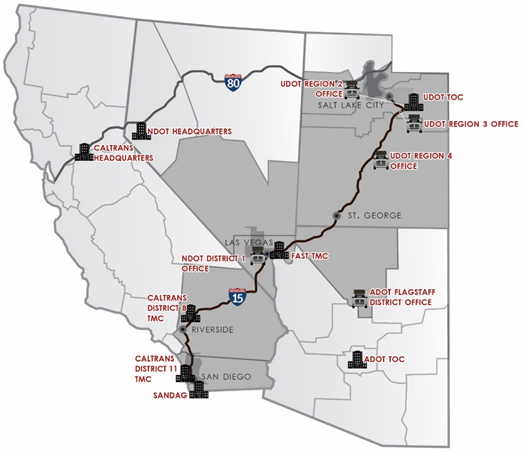Multistate I-15 Dynamic Mobility Project
The I-15 Mobility Alliance was selected as one of six corridor coalitions nationwide to receive federal funding under the Multistate Corridor Operations and Management (MCOM) Program. This funding is being used to execute the I-15 Dynamic Mobility Project (DMP) to take a deeper look into the operation and management of I-15 and develop strategies to support this critical national corridor.
Within the I-15 Corridor Plan, the I-15 Mobility Alliance identified an immediate need to improve real-time information exchange between the states and population centers, as well as improve availability and consistency of interstate traveler information along the corridor. The I-15 DMP is addressing this need by investigating and developing tools and processes that facilitate coordination and communication among transportation operations centers that operate and manage I-15 between San Diego and the northern Utah border.
Learn more about the I-15 DMP via the following accordion and fact sheet.
The I-15 DMP will improve real-time communication and information exchanges among the four I-15 Alliance states. An important goal of the project is to improve agency coordination when incidents, weather, and closures affect I-15. This coordination will ultimately translate into improved advanced warnings and consistent information provided to travelers along I-15.
The DMP team is working with the states to plan and develop a system that will facilitate inter-agency communication, coordination, and information sharing.
The target audience for this project, initially, is staff who are responsible for the day-to-day operations and maintenance of I-15. This includes staff at agency transportation management or operations centers (TMCs/TOCs) and maintenance districts in California (Caltrans Districts 8 and 11), Nevada (NDOT and RTC FAST), Arizona (ADOT) and Utah (UDOT). Other key stakeholders include those involved with information dissemination, incident response, and construction zone management.
The project has been broken out into three phases that build upon one another to ultimately result in the deployment of new collaboration tools and processes at each agency along the I-15 corridor.
Phase 1 includes an assessment of existing assets, as well as needs and goals with respect to the operations of I-15. This information will be used as the foundation for developing a concept for a web-based sharing platform and improved coordination strategies that will address the needs and goals identified.
Phase 2 involves developing system and software requirements for the sharing platform that create the foundation for future software development and data interfaces. The requirements describe the specific functions, interfaces, and other technical aspects that the system must be able to do. This phase also includes exploration of strategies to provide improved information and coordination with other key corridor stakeholders, such as freight operators and law enforcement.
Phase 3 involves the development or modification of software and acquisition of tools that provide the functionalities and interfaces that were specified in the requirements. This phase includes development, testing, and deployment of these tools and processes at each agency and among the targeted user groups.
By facilitating interstate coordination among I-15 Alliance states, this project can result in:
- More consistent and timely information about real-time travel conditions along I-15
- Improved information dissemination about future planned travel conditions along I-15
- Accurate information about emergency detours implemented on the corridor
- Faster and more efficient incident or event response on I-15, especially at state borders
- Improved interstate cooperation on ITS planning, operations, and sharing of best practices
Additionally, the outcomes and lessons learned from this project can benefit other key corridors in the region, such as I-80, which have similar needs with respect to interstate coordination and communication and involve many of the same partnering states.



